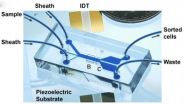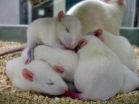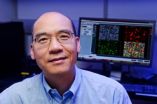(Press-News.org) Researchers at the University of California, San Diego School of Medicine have found one of the keys to why certain glioblastomas – the primary form of a deadly brain cancer – are resistant to drug therapy. The answer lies not in the DNA sequence of the tumor, but in its epigenetic signature. These findings have been published online as a priority report in the journal Oncotarget.
"There is a growing interest to guide cancer therapy by sequencing the DNA of the cancer cell," said Clark Chen, MD, PhD, vice-chairman of Research and Academic Development, UC San Diego Division of Neurosurgery and the principal investigator of the study. "Our study demonstrates that the sensitivity of glioblastoma to a drug is influenced not only by the content of its DNA sequences, but also by how the DNA sequences are organized and interpreted by the cell."
The team of scientists, led by Chen, used a method called comparative gene signature analysis to study the genetic profiles of tumor specimens collected from approximately 900 glioblastoma patients. The method allows investigators to discriminate whether specific cellular processes are "turned on" or "turned off" in glioblastomas. "Our study showed that not all glioblastomas are the same. We were able to classify glioblastomas based on the type of cellular processes that the cancer cells used to drive tumor growth," said Jie Li, PhD, senior postdoctoral researcher in the Center for Theoretical and Applied Neuro-Oncology at UC San Diego and co-first author of the paper.
One of these cellular processes involves Epidermal Growth Factor Receptor (EGFR). The study revealed that EGFR signaling is suppressed in a subset of glioblastomas. Importantly, this suppression is not the result of altered DNA sequences or mutations. Instead, EGFR is turned off as a result of how the DNA encoding the EGFR gene is organized in the cancer cell. This form of regulation is termed "epigenetic." Because EGFR is turned off in these glioblastomas, they become insensitive to drugs designed to inhibit EGFR signaling.
"Our research suggests that the selection of appropriate therapies for our brain tumor patients will require a meaningful synthesis of genetic and epigenetic information derived from the cancer cell," said co-first author Zachary J. Taich.
INFORMATION:Co-authors include Amit Goyal, David Gonda, Johnny Akers, Bandita Adhikari, Kunal Patel and Bob S. Carter, Center for Theoretic and Applied Neuro-Oncology, UCSD; Scott Vandenberg, Department of Pathology, UCSD; Wei Yan, Zhaoshi Bao and Tao Jiang, Department of Neurosurgery, UCSD; Renzhi Wang, Peking Union Medical College Hospital, China; and Ying Mao, Huashan Hospital, Shanghai Medical College, Fudan University, China.
Funding for this research came, in part, from the Sontag Foundation, the Burroughs Wellcome Foundation, the Kimmel Foundation, the Doris Duke Foundation and the Forbeck Foundation.
Finding keys to glioblastoma therapeutic resistance
2014-08-25
ELSE PRESS RELEASES FROM THIS DATE:
Gut bacteria that protect against food allergies identified
2014-08-25
The presence of Clostridia, a common class of gut bacteria, protects against food allergies, a new study in mice finds. By inducing immune responses that prevent food allergens from entering the bloodstream, Clostridia minimize allergen exposure and prevent sensitization – a key step in the development of food allergies. The discovery points toward probiotic therapies for this so-far untreatable condition, report scientists from the University of Chicago, Aug 25 in the Proceedings of the National Academy of Sciences.
Although the causes of food allergy – a sometimes deadly ...
Key to universal flu vaccine: Embrace the unfamiliar
2014-08-25
Vaccine researchers have developed a strategy aimed at generating broadly cross-reactive antibodies against the influenza virus: embrace the unfamiliar.
In recent years, researchers interested in a "universal flu vaccine" identified a region of the viral hemagglutinin protein called the stem or stalk, which doesn't mutate and change as much as other regions and could be the basis for a vaccine that is protective against a variety of flu strains.
In an Emory Vaccine Center study, human volunteers immunized against the avian flu virus H5N1 readily developed antibodies ...
SA's Taung Child's skull and brain not human-like in expansion
2014-08-25
The Taung Child, South Africa's premier hominin discovered 90 years ago by Wits University Professor Raymond Dart, never seizes to transform and evolve the search for our collective origins.
By subjecting the skull of the first australopith discovered to the latest technologies in the Wits University Microfocus X-ray Computed Tomography (CT) facility, researchers are now casting doubt on theories that Australopithecus africanus shows the same cranial adaptations found in modern human infants and toddlers – in effect disproving current support for the idea that this early ...
A long childhood feeds the hungry human brain
2014-08-25
EVANSTON, Ill. -- A five-year old's brain is an energy monster. It uses twice as much glucose (the energy that fuels the brain) as that of a full-grown adult, a new study led by Northwestern University anthropologists has found.
The study helps to solve the long-standing mystery of why human children grow so slowly compared with our closest animal relatives.
It shows that energy funneled to the brain dominates the human body's metabolism early in life and is likely the reason why humans grow at a pace more typical of a reptile than a mammal during childhood.
Results ...
Black carbon -- a major climate pollutant -- also linked to cardiovascular health
2014-08-25
Black carbon pollutants from wood smoke are known to trap heat near the earth's surface and warm the climate. A new study led by McGill Professor Jill Baumgartner suggests that black carbon may also increase women's risk of cardiovascular disease.
To investigate the effects of black carbon pollutants on the health of women cooking with traditional wood stoves, Baumgartner, a researcher at McGill's Institute for the Health and Social Policy, measured the daily exposure to different types of air pollutants, including black carbon, in 280 women in China's rural Yunnan province.
Baumgartner ...
Tilted acoustic tweezers separate cells gently
2014-08-25
Precise, gentle and efficient cell separation from a device the size of a cell phone may be possible thanks to tilt-angle standing surface acoustic waves, according to a team of engineers.
"For biological testing we often need to do cell separation before analysis," said Tony Jun Huang, professor of engineering science and mechanics. "But if the separation process affects the integrity of the cells, damages them in any way, the diagnosis often won't work well."
Tilted-angle standing surface acoustic waves can separate cells using very small amounts of energy. Unlike ...
New biomarker highly promising for predicting breast cancer outcomes
2014-08-25
A protein named p66ShcA shows promise as a biomarker to identify breast cancers with poor prognoses, according to research published ahead of print in the journal Molecular and Cellular Biology.
Cancer is deadly in large part due to its ability to metastasize, to travel from one organ or tissue type to another and malignantly sprout anew. The vast majority of cancer deaths are associated with metastasis.
In breast cancer, a process called "epithelial to mesenchymal transition" aids metastasis. Epithelial cells line surfaces which come into contact with the environment, ...
Exposure to toxins makes great granddaughters more susceptible to stress
2014-08-25
Scientists have known that toxic effects of substances known as endocrine disrupting chemicals (EDCs), found in both natural and human-made materials, can pass from one generation to the next, but new research shows that females with ancestral exposure to EDC may show especially adverse reactions to stress.
According to a new study by researchers from The University of Texas at Austin and Washington State University, male and female rats are affected differently by ancestral exposure to a common fungicide, vinclozolin. Female rats whose great grandparents were exposed ...
MU researchers discover protein's ability to inhibit HIV release
2014-08-25
COLUMBIA, Mo. — A family of proteins that promotes virus entry into cells also has the ability to block the release of HIV and other viruses, University of Missouri researchers have found.
"This is a surprising finding that provides new insights into our understanding of not only HIV infection, but also that of Ebola and other viruses," said Shan-Lu Liu, M.D., Ph.D., associate professor in the MU School of Medicine's Department of Molecular Microbiology and Immunology.
The study was recently published in the Proceedings of the National Academy of Sciences. Liu, the ...
Cancer-fighting drugs might also stop malaria early
2014-08-25
DURHAM, N.C. -- Scientists searching for new drugs to fight malaria have identified a number of compounds -- some of which are currently in clinical trials to treat cancer -- that could add to the anti-malarial arsenal.
Duke University assistant professor Emily Derbyshire and colleagues identified more than 30 enzyme-blocking molecules, called protein kinase inhibitors, that curb malaria before symptoms start.
By focusing on treatments that act early, before a person is infected and feels sick, the researchers hope to give malaria –- especially drug-resistant strains ...



